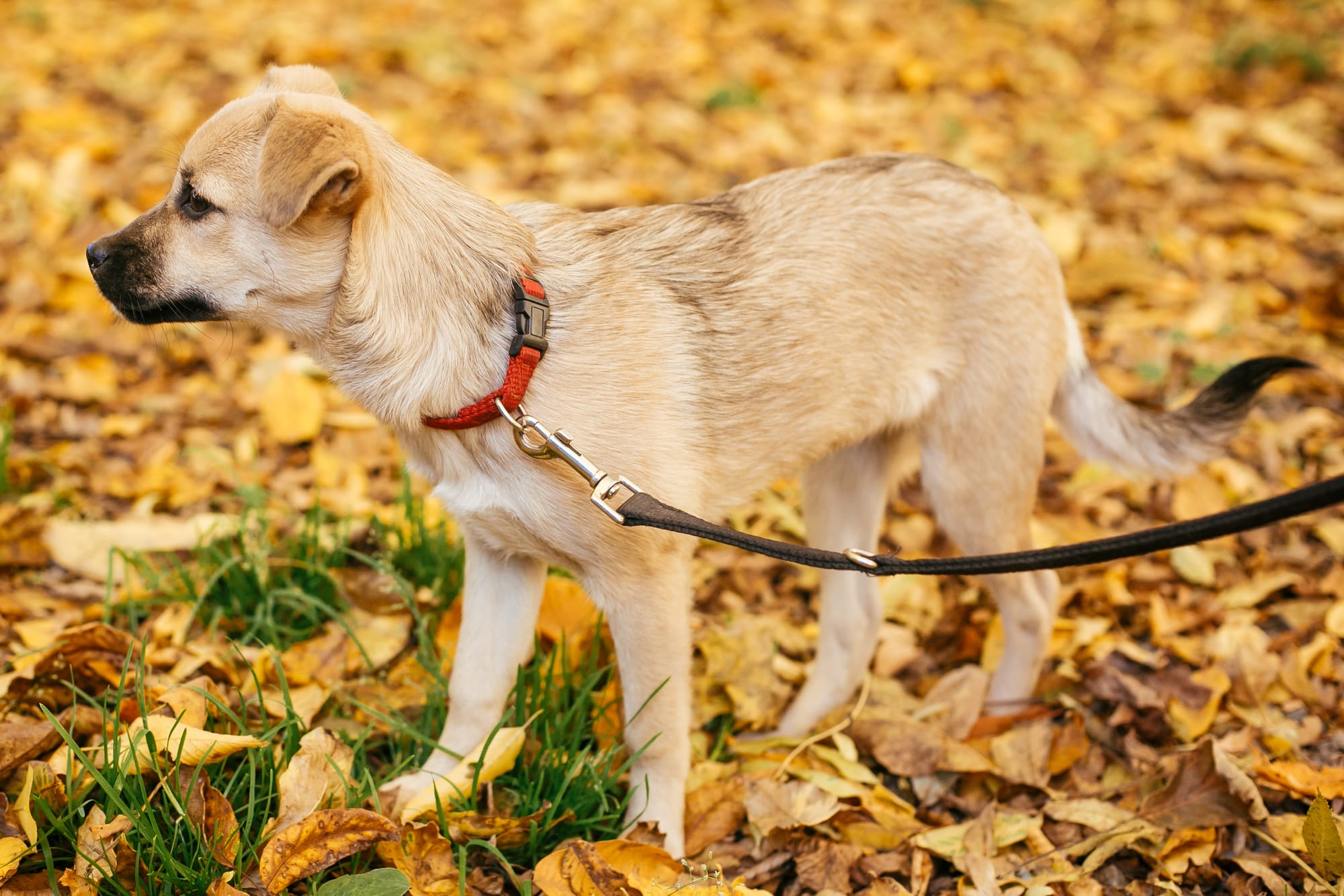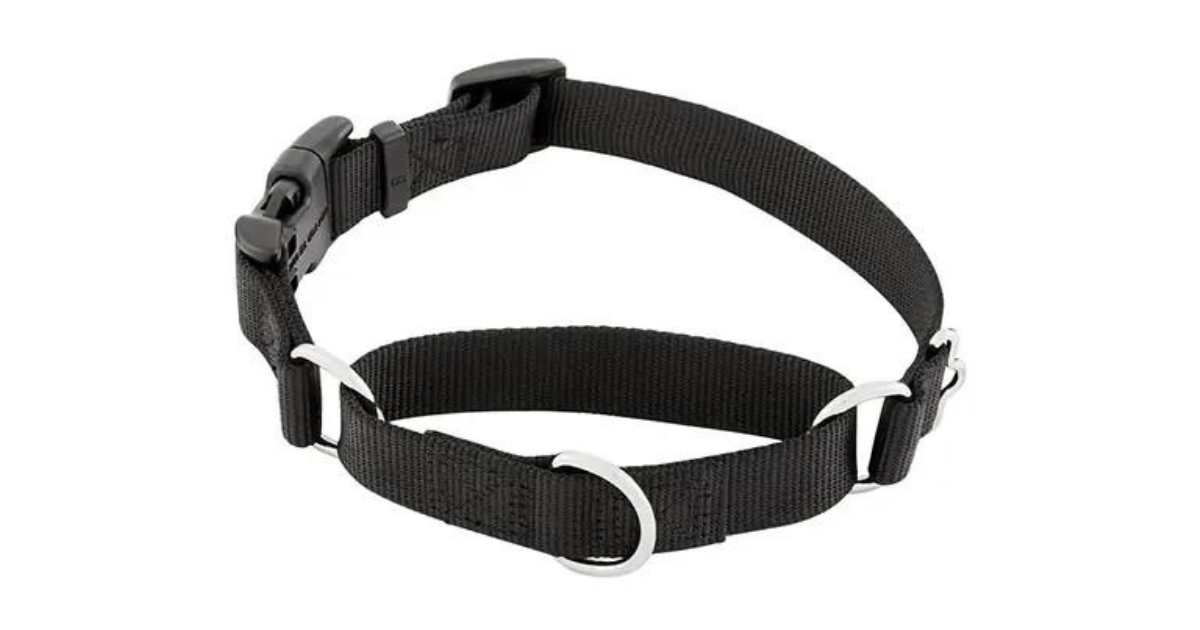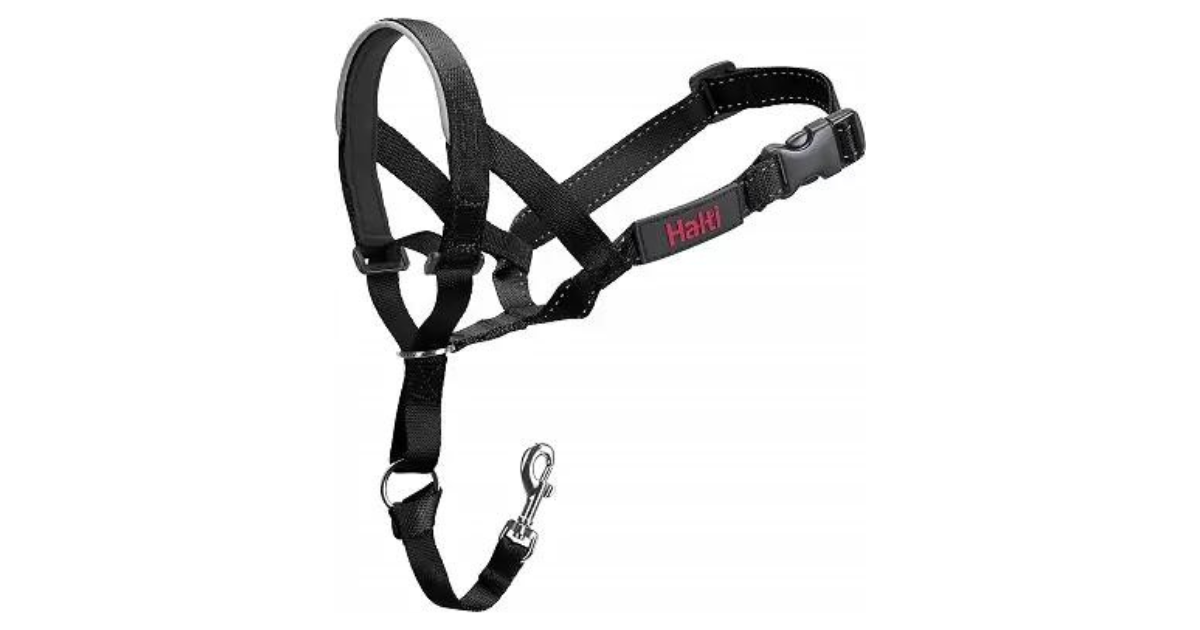Dog owners know that one of the most common challenges of walking their furry friend is dealing with a pulling dog. A pulling dog can be frustrating, and it can also be dangerous for the dog's neck and chest. That's why finding the best collar for dogs that pull is crucial.

With so many different types of dog collars available, it can be overwhelming to choose the right one. Some dog owners turn to prong collars or choke collars, but these can cause harm to a dog's neck and are not recommended by most trainers.
In this comprehensive guide, we'll explore the key factors to consider when selecting a dog collar. We will review some of the best dog collars for pulling, including head halters, martingale collars, and no-pull dog harnesses. As a responsible dog owner, choosing the right collar is important to ensure your dog's safety and comfort during walks.
Ensure the safety of your pulling dog with the Fi Dog Collar
Managing a dog that pulls on the leash can be a challenge, but the Fi Dog Collar provides an additional layer of safety and security for your furry friend. With its advanced GPS tracking, this collar helps you keep tabs on your dog's location in real-time, giving you peace of mind whether you're on a walk or your pup manages to slip out of their regular collar.
The Fi Dog Collar doesn't just track location; it also monitors activity levels and sleep patterns, helping you better understand your dog's health. The collar features long-lasting battery life, is fully waterproof, and is durable enough to withstand even the most energetic dogs.
Don't take chances with your dog's safety—invest in the Fi Dog Collar today and ensure that no matter how much they pull, they're always within reach.
Features of a good collar for dogs that pull
Many dog owners struggle with their pets that pull while on a walk. It can be a frustrating experience and can make walking your furry friend an unpleasant task. One solution is to invest in a good no-pull dog harness or collar. Here are some important features to look for when selecting a collar for dogs that pull:
- 1. Proper fit and adjustability: Choosing a collar that fits your dog's body is crucial. A collar that is too tight can harm the dog's throat, and one that is too loose can slip off. Look for collars with adjustable straps to ensure a comfortable and snug fit for your furry friend.
- 2. Material and durability: Dogs that pull need a sturdy collar to withstand their pulling force. Look for collars made of durable materials such as nylon or leather and those with reinforced stitching to prevent tearing.
- 3. Comfort and padding: A collar that is comfortable for your dog will reduce the chances of them resisting it. Look for soft padding or breathable mesh collars to prevent chafing and irritation.
- 4. Safety features: A good collar should have safety features that help keep your pet safe. Look for collars with reflective elements to increase visibility during nighttime walks or soft plastic points that prevent choking and rubbing on your dog's neck.
It is worth noting that no-pull collars come in different types, including training collars, head collars, choke, and prong collars. A certified dog trainer or professional dog trainer can help you choose the right type of collar for your dog based on their walking habits and behavior.
Sometimes, a no-pull dog harness may be a better option for large dogs or dogs that pull excessively. A no-pull harness fits around the dog's body, making it harder for the dog to pull with its full force.
Using a Fi GPS Collar for Safety
If you have a dog that pulls during walks, you know how frustrating it can be. While there are many types of collars that can help discourage pulling, using a Fi GPS dog collar in tandem with your regular collar can provide an extra layer of security for your furry friend. By attaching the Fi collar to your dog's regular collar, you'll be able to track their location if they happen to escape.
We recommend attaching a leash to your walking collar, so the Fi collar can stay on your dog even if they manage to slip out of their other collar. With the Fi collar, you can have peace of mind knowing that your dog is always within reach. Whether you're out on a hike or just taking a walk around the block, the Fi GPS dog collar can help keep your pet safe and secure.
Top collar types for dogs that pull
1. Frisco Solid Nylon Martingale Dog Collar

Frisco Solid Nylon Martingale Dog Collar is a collar designed for dogs that pull. It is made of durable nylon webbing and features a limited-slip martingale mechanism that gently tightens when the dog pulls, providing gentle pressure around the dog's neck and discouraging pulling behavior.
Pros:
- The limited-slip mechanism prevents the collar from becoming too tight, making it a safer alternative to choke collars.
- The gentle pressure around the neck can redirect the dog's attention and discourage pulling behavior without causing discomfort or pain.
- The collar is durable and can withstand regular wear and tear.
- It can help to train dogs to walk on a leash and make them more manageable in public spaces like dog parks.
Cons:
- Some dog owners may not be comfortable using a collar that tightens around their dog's neck, even if it is a limited-slip collar.
- It may not be effective for all types of dogs, especially stubborn dogs requiring more intensive training.
- It may not be suitable for dogs with thick necks, as the collar may not fit properly or comfortably.
- It may not be the best option for dogs with sensitive skin or those who are prone to skin irritations.
Popular brands and models of no-pull collars include the Petsafe Easy Walk Harness, the Petsafe Gentle Leader, and various anti-pull harnesses and head halters. It is important to consider the dog's temperament and individual needs when selecting a collar or harness and to ensure that it fits properly and is comfortable for the dog to wear.
2. StarMark TCLC No Pull Dog Training Collar

The StarMark TCLC No Pull Dog Training Collar is designed to help train dogs not to pull on the leash. The collar tightens around the dog's neck when they pull, providing a gentle correction that discourages the behavior.
Pros:
- The collar is designed to be gentle on the dog's neck, using pressure to correct behavior rather than pain.
- It is a good option for dogs who have not responded to other training methods or for dogs who pull excessively.
- The collar is available in different sizes, making it suitable for toy breeds, medium-sized dogs, and larger breeds.
- It can be used in conjunction with a regular collar or a harness, depending on the dog's needs.
Cons:
- Some dog owners may not be comfortable using a collar that tightens around their dog's neck, even if it is a training collar.
- The collar may not be suitable for dogs with a sensitive neck or throat area.
- It may not be as effective for very strong or stubborn dogs.
- The collar should not be left on the dog when unsupervised, as it could become tangled or caught on something.
Popular brands and models of no-pull collars include the Petsafe Easy Walk Harness, martingale collars, head harnesses, and other types of collars and harnesses with unique features. It is important to choose a collar or harness that fits properly and is comfortable for the dog to wear and to use training methods that are appropriate for the dog's temperament and ability level.
3. Sporn No-Pull Dog Collar Halter

The Sporn No-Pull Dog Collar Halter is a collar and harness combination designed to help train dogs not to pull on the leash. The collar fits around the dog's neck, and the harness clips onto the dog's chest, providing a point of control and discouraging pulling behavior.
Pros:
- The collar and harness combination can provide better control and balance than using just a collar or harness alone.
- The harness design allows gentle pressure to be applied to the dog's chest, redirecting its attention and discouraging pulling behavior.
- The collar and harness are durable and can withstand regular wear and tear.
- It can effectively train dogs to walk on a leash, making them more manageable in public spaces.
Cons:
- Some dog owners may not be comfortable using a collar that tightens around their dog's neck, even if it is a limited-slip collar.
- It may not be suitable for dogs with thick necks or short snouts, as the collar and harness may not fit properly or comfortably.
- The collar and harness may not be suitable for all dogs, especially those requiring more intensive training or those with certain medical conditions.
- It may be more expensive than other types of training collars or harnesses.
Popular brands and models of no-pull collars and harnesses include prong collars, choke collars, martingale collars, and various types of no-pull dog harnesses. It is important to consider the dog's temperament and individual needs when selecting a collar or harness and to ensure that it fits properly and is comfortable for the dog to wear. Dog trainers may also be able to provide guidance on the best collar or harness for a particular dog's needs.
4. Country Brook Martingale Dog Collar

The Country Brook Martingale Dog Collar is a collar designed to provide gentle control for dogs that pull on the leash. It features a martingale mechanism that tightens when the dog pulls, providing gentle pressure around its neck and discouraging pulling behavior.
Pros:
- The limited-slip mechanism prevents the collar from becoming too tight, making it a safer alternative to choke collars.
- The collar is made of high-quality materials and can withstand regular wear and tear.
- It can effectively train dogs to walk on a leash, making them more manageable in public spaces.
- The collar is available in different sizes, making it suitable for large dogs and many others.
Cons:
- Some dog owners may not be comfortable using a collar that tightens around their dog's neck, even if it is a limited-slip collar.
- It may not be suitable for dogs with a sensitive neck or throat area.
- It may not be as effective for very strong or stubborn dogs.
- It may not be the best option for dogs with certain medical conditions or those not responding to other training methods.
Popular brands and models of no-pull collars and harnesses include head collars, choke, and prong collars, other types of training collars, and various types of no-pull dog harnesses. It is important to consider the dog's body and walking habits when selecting a collar or harness and to ensure that it fits properly and is comfortable for the dog to wear. Certified dog trainers may also be able to provide guidance on the best collar or harness for a particular dog's needs.
5. Halti Head Collar Suited for Dogs That Pull

The Halti Head Collar is a type of training collar designed to help control dogs that pull on the leash. It fits over the dog's nose and head, providing a point of control that redirects the dog's attention and discourages pulling behavior.
Pros:
- The collar provides gentle control by redirecting the dog's head and discouraging pulling behavior without causing pain or discomfort.
- It is a good option for dogs that are difficult to control with other types of collars or harnesses.
- The collar is available in different sizes, making it suitable for large dogs and many others.
- It can effectively train dogs to walk on a leash, making them more manageable in public spaces.
Cons:
- Some dog owners may find the collar difficult to wear or uncomfortable using a collar that fits over their dog's nose.
- The collar may not be suitable for dogs with certain medical conditions or those not responding to other training methods.
- It may not be the best option for dogs with sensitive noses or faces.
- It may be more expensive than other types of training collars or harnesses.
Popular brands and models of no-pull collars and harnesses include prong collars, choke collars, martingale collars, and various types of no-pull dog harnesses. It is important to consider the dog's walking habits and individual needs when selecting a collar or harness and to ensure that it fits properly and is comfortable for the dog to wear. Certified dog trainers may also be able to provide guidance on the best collar or harness for a particular dog's needs.
Popular brands and models of no-pull collars and harnesses include head collars, choke, and prong collars, other types of training collars, and various types of no-pull dog harnesses. It is important to consider the dog's individual needs and ability when selecting a collar or harness and to ensure that it fits properly and is comfortable for the dog to wear. Certified dog trainers may also be able to provide guidance on the best collar or harness for a particular dog's needs.
Tips for training your dog not to pull
Training your dog not to pull on the leash can be a challenging but rewarding process. Here are some tips to help you train your dog to walk nicely on a leash:
- Positive reinforcement techniques: Reward your dog with treats or praise when they walk nicely on the leash. This will encourage good behavior and make walking more enjoyable for both you and your dog.
- Consistency in training: Be consistent with your training and use the same techniques every time you walk your dog. This will help reinforce good behavior and prevent confusion.
- Gradual introduction of distractions: Gradually introduce your dog to new distractions, such as other dogs or people, as you walk. This will help your dog learn to focus on you and not be distracted by their surroundings.
- Seeking professional help when needed: If you're struggling with training your dog not to pull on the leash, consider seeking help from a certified dog trainer. They can provide guidance and support to help you achieve your training goals.
In addition to these tips, using a no-pull collar or harness can also be helpful in training your dog not to pull on the leash. It's important to find a collar or harness that fits your dog properly and is comfortable for them to wear.
Conclusion
Choosing the best dog collar for dogs that pull can be difficult for pet owners. With so many types of collars available, including head collars, choke and prong collars, no-pull harnesses, and more, pet owners may feel overwhelmed when selecting the best collar for their pulling dog. However, by understanding the different types of dog collars available and their pros and cons, pet owners can make an informed decision based on their dog's needs and individual temperament.
Positive reinforcement techniques, consistency in training, and gradual introduction of distractions are key elements of successful dog training, regardless of the type of collar or harness used. Pet owners need to seek help from a certified dog trainer when struggling with training their dogs.
Ultimately, the best dog collar for a pulling dog will depend on the individual dog's needs and the owner's preference. Pet owners should select a collar or harness that fits properly and is comfortable for the dog to wear while also effectively stopping their dog from pulling on the leash. With the right collar and training techniques, pet owners can enjoy stress-free walks with their dogs in the dog park and other public spaces.
One last final tidbit would be to try and train your dog to heel. This will also help with the pulling issue so you can enjoy more walks with your pup!
For more helpful articles about pet-parenting tips, check out the Off Leash blog at TryFi.com.
Want to know more about TryFi.com? The Fi Dog Collar is a GPS tracking collar that not only keeps track of your dog’s location, activity levels, and sleep patterns, but it also alerts you if your dog escapes your backyard. This is the fastest way to find your dog after an escape. Try the Fi Dog Collar today!





